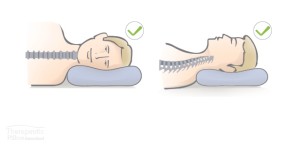I have treated neck pain and headaches on a daily basis for a few decades and one of the most frequent questions I get asked is: ‘Which is the best pillow?’
Let me educate you about sleeping position and neck pain then let you figure out which is the right pillow for you.
Tip number 1: It’s not the pillow’s fault.
Okay. So this first point is not trying to make the whole article redundant. Hear me out.
People always blame their pillow for their neck pain because they are kept awake with neck pain or they wake up with neck pain. Simply because the night time is when the pain occurs means the pillow is the assumed culprit. In reality, most people who get neck pain at night have problems in their neck that are there 24/7 and may have been there for years. The fact that you get symptoms at night and not during the day is very common. In most cases, good treatment to fix the neck means even with no pillow replacement the pain at night is gone.
Tip number 2: The pillow’s height is all that really matters.
The golden rule for your spine is that it wants to rest in a neutral position. Neutral when standing means head is straight, squarely above the shoulders. Not tilted forward, not tilted backward, not tilted right or left – neutral. In other words when you stand up straight like a soldier your head is in a neutral position.  This is the position that your neck prefers to be in when you rest. The golden rule is use whatever thickness of pillow is required to support your head in that neutral position while you are lying down. Some brands of pillow have inserts that can be removed to adjust the height and most good brands will make a variety of thicknesses.
This is the position that your neck prefers to be in when you rest. The golden rule is use whatever thickness of pillow is required to support your head in that neutral position while you are lying down. Some brands of pillow have inserts that can be removed to adjust the height and most good brands will make a variety of thicknesses.
Tip number 3: Determine your preferred sleeping position.
If you are predominantly a side sleeper then you need a thickish pillow. How thick? How wide are your shoulders? Determine how much thickness you need to keep your head neutral?
If you are a back sleeper then you need a thinnish pillow to ensure that your chin is not being pushed toward your chest.
Some people say ‘I sleep in 12 different positions’. Fair enough. In this scenario you can buy a pillow that is thick on one half (for side sleeping) and thin on the other half (for back sleeping). This can work. Moving the pillow to suit in the middle of your sleeping pattern I will leave for you to figure out.
Tip number 4: Be aware of old habits.
When you are determining the thickness of pillow that you need, be aware that you may have learned to sleep with your hand under your head. This is a way of ‘propping up’ a pillow that is too thin. If you get a new pillow that is the right height, you may need to train yourself not to do this. Rolling onto your front and turning your head is another way of making up for a pillow that is not thick enough. With a pillow the correct height you should be able to sleep more easily on your side.
Tip number 5: Use material that will last.
One of the biggest problems people find in the long term is that the ‘perfect pillow’ doesn’t stay perfect for long. The frustrating thing is that when you put your 10 pound head on it every night, it gets thinner. Then after three months it’s not the perfect pillow for you any more. Materials like latex and memory foam will retain their height for a long time whereas lesser foams, wool or synthetic fills will not.
Finally, if you are one of the hundreds of people I have seen who have a cupboard full of different pillows and are still searching for the perfect one – it ain’t out there. Stop wasting your money, invest in a course of Myotherapy treatment to FIX your neck, then the right pillow will keep you feeling fine for the long term.
Therapeutic Pillow is an Australian company that makes honest, affordable pillows so check out their products for a top pillow.
If this article has been useful then punch your name and email into the side bar or on the front page and have new articles sent to you as I write them.
– Tim



